The Arcadia Woodland (and its possible future)
December 14, 2010 § 13 Comments
Escorted by Cam Stone, a long-time resident of the Arcadia foothills, two Sierra Club members and I passed through a series of locked gates en route to an ageless, enduring place that in recent days has become perilously ephemeral. Inspired by Jessica’s previous post on plans to raze the 11-acre old-growth oak woodland, I felt immediately compelled to see it, to hear it, to feel it beneath my feet. The Woodland was unknown to me prior to reading the post but minutes later I found myself making phone calls to writers and local residents already involved in the story, eagerly trying to find a way to go. There are so few remnant places like this in the area and I was awestruck to find out that the County was actually planning on wiping the Woodland off the map to make way for a stockpile of sediment. Working as a landscape architect on a number of watershed-related projects in the area, I am quite accustomed to efforts that make an attempt to approximate a place like the Arcadia Woodland, so accustomed that my naivety led me to believe that such places are no longer under threat of development, that the destruction of wildlands in L.A. has reached a tipping point, and that it would be folly to bulldoze further.
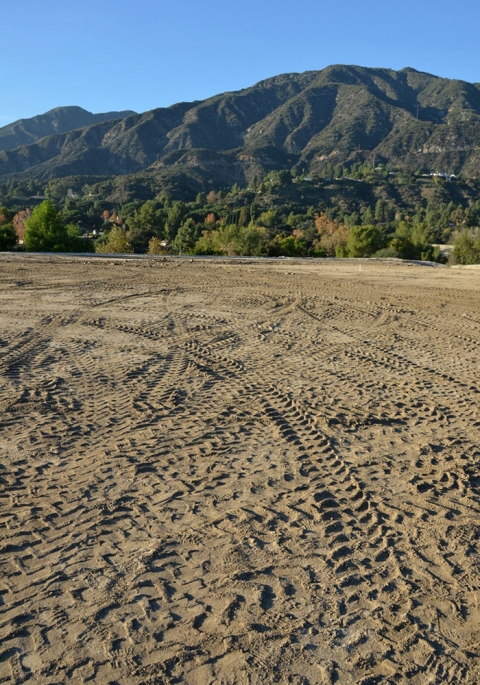
The level "mesa" atop the Upper Sediment Disposal Site. A similar fate awaits the Arcadia Woodland just to the south.
Upon passing existing spreading grounds and crossing the channelized Santa Anita Wash, we were confronted with a barren slope ahead, otherwise known as the “Upper Sediment Disposal Site”. As Cam explained it, this was the active disposal site for material deposited behind Santa Anita Dam. With an appearance reminiscent of a landfill, the engineered slopes of the massive pile were interrupted by periodic rilling, a sure sign of erosion. Though scant non-native ornamental trees dotted the slope, defoliant sprayed by the County ensured a clean surface devoid of life under-story. Equally intriguing when considering this poisoned sterilized landscape was the “NO DUMPING – THIS DRAINS TO THE OCEAN” sign on the adjacent channel fence. As we made our way south over the sculpted barren mesa, we passed construction trailers, dozers, and large caches of boulders until finally reaching the edge of the man-made earthen mound. The startling contrast between the disposal site we were standing on and the rich diversity of vegetation below us made for an experience that will resonate with me for years to come. Looking over the Woodland, it felt as if we were gazing upon a lost world. The thought of another thirty-foot high disposal site in its stead brought a queasy feeling to my stomach. We passed through a large culvert and emerged on the other side to see the woodland at eye-level.
Words and pictures really cannot describe the experience of walking through the woodland. There is a timeless quality about it that seeps endlessly from its core. The diversity of the vegetation on the site is staggering: coast live oak, western sycamore, bay laurel, toyon, laurel sumac, sugar bush, ceanothus, redberry, coffeeberry, golden currant, white sage, California sagebrush, chaparral yucca, poison oak, prickly-pear cactus, etc. A rich tapestry of tender saplings and senescent trees (and everything in between) creates a sense of perpetuity and continuum. The soil is so rich, the leaf litter so thick that at times you sink nearly knee-deep into it. While walking along the main path through the site, we came upon fresh bear prints in the mud and nearby mule deer prints as well. The verdant, earthy fragrance of the place provides a reminder that this is no mere collection of 179 oaks and 70 sycamores. It is a complex living system that no mitigation project could ever replace. Considering the collective brain power employed in County offices, there must be a more constructive solution to the ongoing maintenance of reservoirs and debris basins in the area, a counterpoint to the currently impoverished, near-sighted approach to watershed management and flood control?
While we were walking, Cam mentioned that this woodland was his childhood playground, a note that immediately struck me since I too had spent much of my childhood under the watchful eye of these foothills. I understood his sentiment for the woodland without him having to say a word. Places like this become part of you, shaping you in ways so profound they fall below your radar until you must confront a world without that place. Like the loss of a loved one, you mourn it, but in a different way, because you never expected that it would be gone. There is time, albeit fleeting, to save the woodland. Speaking as one who has been there, this exquisite example of L.A.’s natural heritage is well worth saving. A big thanks to Jessica for sparking my curiosity and for the opportunity to post! Another big thanks to Cameron Stone for giving us the tour of his amazing childhood playground.
To view more photos of the woodland, click here.
Community Meeting Update via Weeding Wild Suburbia: Thursday, December 16th, 7:00PM, Highland Oaks Elementary (Santa Anita Ave. & Virginia Rd.)
Also, as Jessica has already suggested, contact your local County Supervisor and let them know your thoughts.

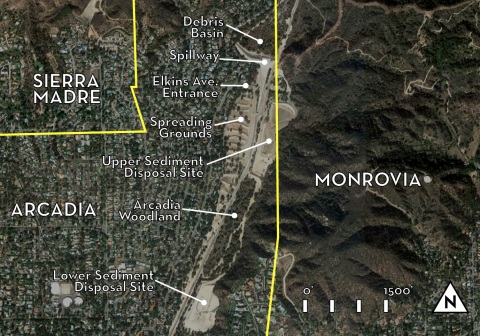
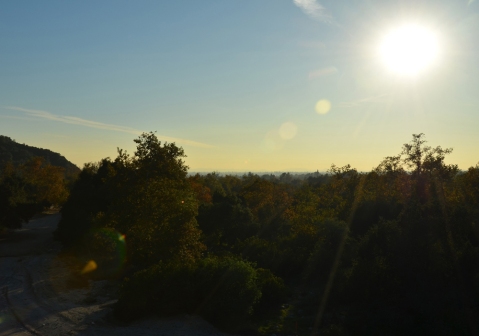
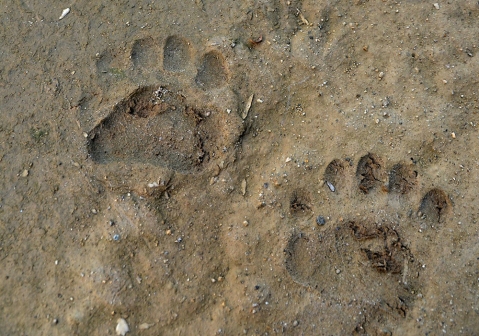
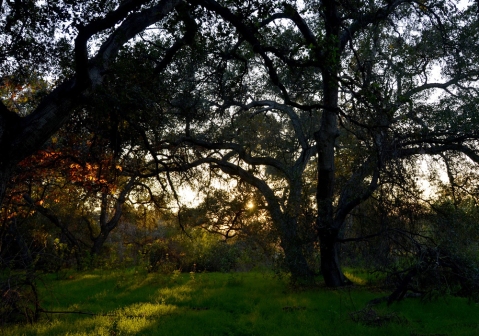
thank you for this moving piece of writing. bear tracks!!!
with leaf litter that deep, i bet it would be a good site for mushroom hunting.
You put into beautiful words describing this incredible treasure.Thanks
My comment is to the County. Debris has been coming down from these hills for eons and will continue to do so. If you go ahead with the destruction of the Woodland and fill it with debris, where will you put the debris once the Woodland site is filled?
At that point, you will have destroyed the Woodland and will need to find another site for the debris. Why not save the Woodland and find the new site now?
Thanks very much for this splendid piece of writing and for the helpful diagram.
“Places like this become part of you, shaping you in ways so profound they fall below your radar until you must confront a world without that place.”
so true
you have to fight so hard to keep it
[…] Creek Freak’s Joshua Link has an important post calling attention to LA County’s plans to destroy 11 acres of old growth forest in […]
[…] Creek Freak’s Joshua Link has an important post calling attention to LA County’s plans to destroy 11 acres of old growth forest in […]
[…] L.A. Creek Freak (12/4/10), Weeding Wild Suburbia (12/6/10), Weeding Wild Suburbia (12/12/10), L.A. Creek Freak (12/14/10), Weeding Wild Suburbia (12/19/10) LA Vitamin Report […]
[…] so squeamish about transport. For a December LA Times piece, click here and LA Creek Freak on it, here. Rancho Santa Ana Botanic Garden research fellow Barbara Eisenstein has a first class chronology of […]
[…] LA Creek Freak (description of site) […]
I wanted to forget it happened but I can’t. It was leveled January 12, 2011 and here it is June 20, 2013. The county spokesperson Chris Stone told us last night that this SPS (Sediment Placement Site) is their “mitigation” zone in perpituity. Which means they will keep pointing to their cultivated silt hills as a badge of honor while they continue to dump sediment or scrap out sediment in the sacred places repressed from their understanding.
Mahalo, Joshua Link.
Reblogged this on Princess HAHA and commented:
I wanted to forget it happened but I can’t. It was leveled January 12, 2011 and here it is June 20, 2013. The county spokesperson Chris Stone told us last night that this SPS (Sediment Placement Site) is their “mitigation” zone in perpituity. Which means they will keep pointing to their cultivated silt hills as a badge of honor while they continue to dump sediment or scrap out sediment in the sacred places repressed from their own understanding.
Mahalo, Joshua Link.